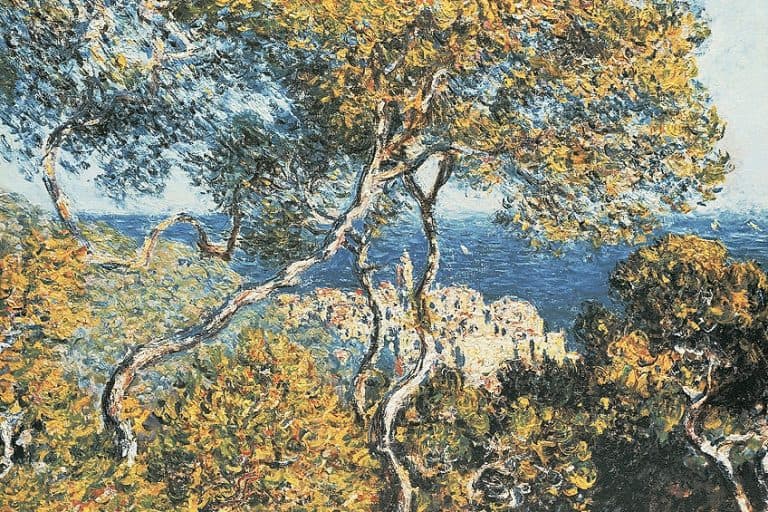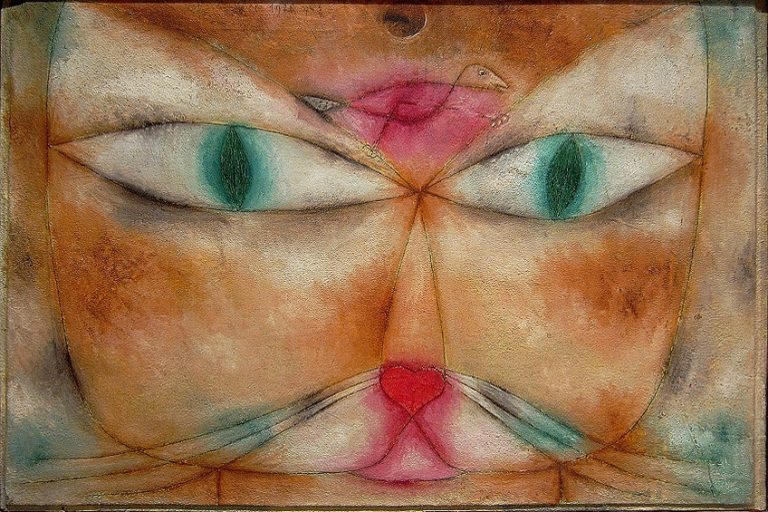“Dance at Bougival” by Pierre-Auguste Renoir – A Jovial Artwork
Pierre-Auguste Renoir was a beloved Impressionist and created numerous well-known paintings that are adored to this day. One of these includes his full-length double portrait titled Dance at Bougival (1883), which focuses on a charming French and fashionable couple, which this article will discuss in more detail below.
Artist Abstract: Who Was Pierre-Auguste Renoir?
Pierre-Auguste Renoir was one of the leading Impressionist artists active during the 19th century. He was born on February 25, 1841, in the city of Limoges, France, and died on December 3, 1919, in Cagnes-sur-Mer in South-Eastern France.
Renoir was known for his subject matter which ranged from portraits, landscapes, nudes, and everyday scenes of people dancing, dining, and being fashionably immersed in their activities.

He exhibited at the Paris Salon as well as at the Impressionist exhibitions. Some of his famous paintings include Dance at the Moulin de la Galette (1876), Luncheon of the Boating Party (1881), and Two Sisters (On the Terrace) (1881).
Dance at Bougival (1883) by Pierre-Auguste Renoir in Context
| Artist | Pierre-Auguste Renoir |
| Date Painted | 1883 |
| Medium | Oil on canvas |
| Genre | Portrait painting |
| Period/Movement | Impressionism |
| Dimensions (cm) | 181.9 x 98.1 |
| Series/Versions | Part of a collection of three dance paintings |
| Where Is It Housed? | Museum of Fine Arts, Boston, Massachusetts, United States |
| What It Is Worth | It was reportedly purchased for $150, 000 from Jacques Seligmann in 1937. |
This article will discuss the Dance at Bougival painting analysis when it was painted, and who commissioned it, including a discussion of the subject matter and Renoir’s artistic style according to the elements of art.
Contextual Analysis: A Brief Socio-Historical Overview
Dance at Bougival by Pierre-Auguste Renoir is part of a collection of three paintings that feature a dancing couple. The paintings were commissioned by the art dealer Paul Durand-Ruel, and all three were painted in 1883. The other two paintings are titled Dance in the Country (1883) and Dance in the City (1883).
As the title suggests in the Dance at Bougival painting, Bougival is a city just outside of Paris.
It was also a famed place for the Impressionist artists like Renoir, Berthe Morisot, Claude Monet, and Alfred Sisley, who visited, stayed, and painted the surrounding scenery. The scene Renoir painted here has been described as taking place at an open-air café in Bougival.
Who Are the Dancers?
The couple dancing in the Dance at Bougival painting were thought to be Suzanne Valadon and Paul Auguste Lhote, however, there has been scholarly debate around the identity of these models. According to various X-ray studies made on the painting, Renoir may have started painting another woman before he chose to paint Suzanne Valadon as the model in Dance at Bougival.
This has been noted due to the changes in anatomy. It may have been Aline Charigot, who, interestingly, married Renoir in 1890 and modeled for other paintings by him, namely “Dance in the Country” (1883) and “Luncheon of the Boating Party” (1881).

The male model in Dance at Bougival is known to be Paul Auguste Lhote, who also posed for Dance in the Country (1883) and Dance in the City (1883). However, it has been suggested that this could have also been Hippolyte-Alphonse Fournaise, whose redder hair color matched that of the model in the Dance at Bougival painting.
Formal Analysis: A Brief Compositional Overview
The Dance at Bougival painting analysis will start with a visual description of the subject matter leading into an overview of how the art elements are arranged and simultaneously compose the painting.
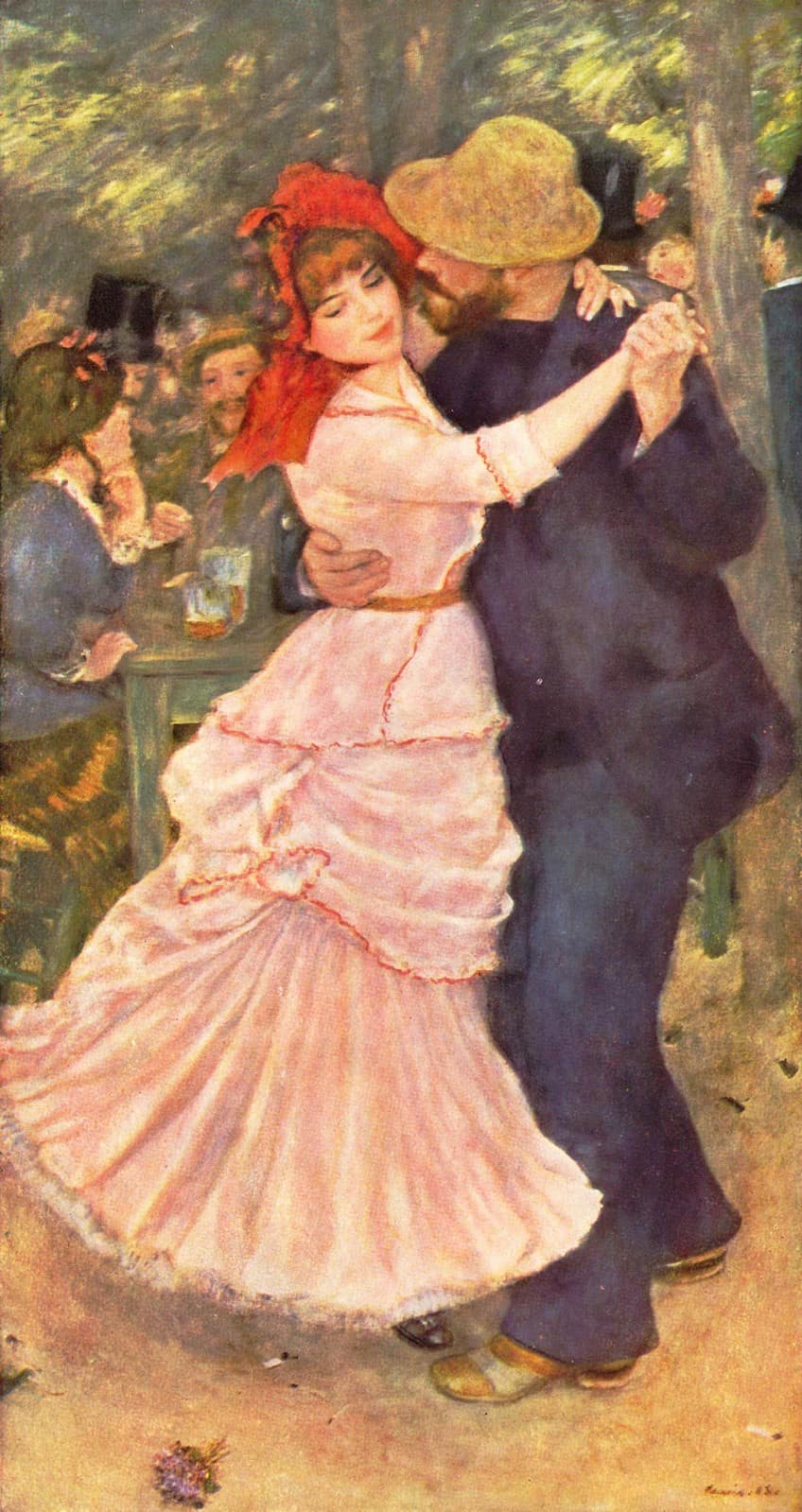
Subject Matter: Visual Description
The Dance at Bougival by Pierre-Auguste Renoir depicts an outdoor scene of two people, a woman to the left and a man to the right dancing with one another in the foreground. There are several other people in the background surrounded by trees; to the left are people sitting at a table and to the right are people standing. They all appear jovial while socializing.
The main couple in the foreground catches our, the viewers’, attention. They appear to be dancing a Waltz; the woman is serenely gazing to her right with her head slightly tilted and the man appears to be concentrating on her while he leads her in the dance.
His eyes are hidden under the brim of his hat, but his body language appears fully engrossed in his partner. The woman is wearing a light pink cotton outfit that consists of a three-quarter-sleeved bodice and a skirt with red edgings. Around her waist is a gold-colored belt and she is wearing a red hat topped with decorative dark purple fruit on its right side (our left). The tip of what appears to be her right shoe peeks out from under her full-length skirt.

The man is wearing a dark blue suit with what has been described as a dark blue sweater and white undershirt underneath his jacket. He is wearing light brown shoes with a strip of white in between the brown, and a light brown, brimmed, straw hat. He appears to have a neatly trimmed beard and mustache. Scattered on the ground, or dance floor in this case, are various items like cigarette buds, used matches, and flowers, which leave the impression of a well-utilized dancing area.
On the table in the background are what appear to be glasses with beer or spirits in them as the people are happily conversing with one another.
Color
The color scheme of Dance at Bougival by Pierre-Auguste Renoir consists of lighter pastel colors. There is also a contrast between the paler pink of the woman’s outfit compared to the deeper blue of the man’s suit. While the background consists of cooler blues and greens, the woman’s pink outfit and red hat contribute warmer colors in the foreground.
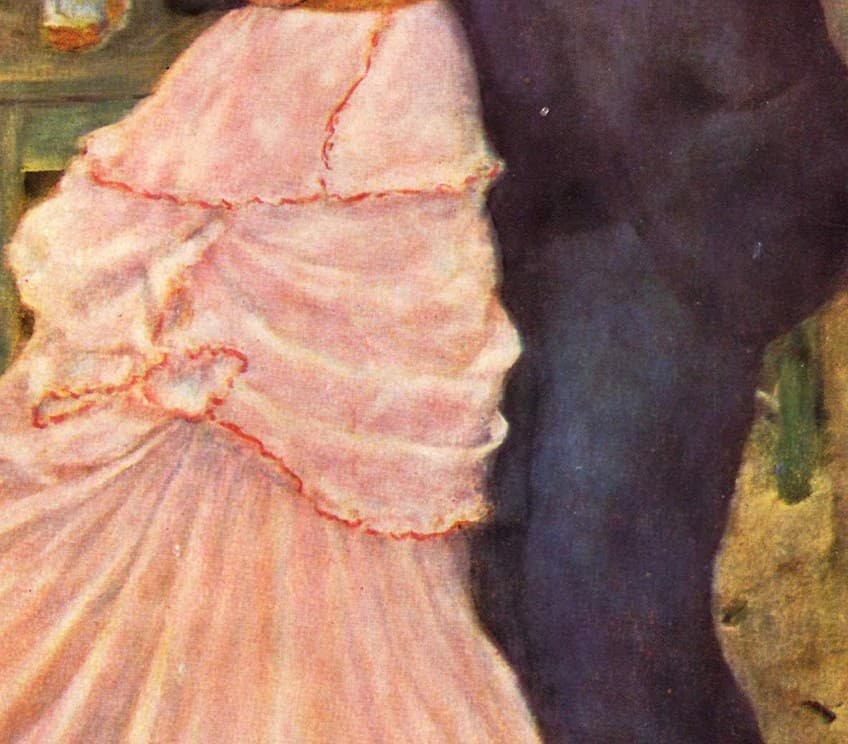
Texture
Pierre-Auguste Renoir utilizes loose and expressive brushstrokes in the Dance at Bougival painting, which creates a sense of movement and fleetingness of the dancing moment. Renoir was known for his unique utilization of brushwork and here you will notice the choppy diagonal brushstrokes along the upper portion or the softer scumbles of brushstrokes along the frills of the woman’s skirt.

Line
In Dance at Bougival by Pierre-Auguste Renoir, the figures’ outlines are not overtly visible but blend from one color to the next. There are also a variety of lines, for example, diagonal lines created from the brushstrokes along the upper edge of the composition and naturalistic curved lines in the dancing couple’s clothing. There are more geometric horizontal and vertical lines composing the table to the left in the background.
Additionally, the trees also imply vertical linearity, which is echoed by the vertical orientation of the painting and dancing couple.

Shape and Form
The dominant shapes and forms in Dance at Bougival by Pierre-Auguste Renoir are naturalistic, or irregular, which are created through other art elements like color or brushstrokes, for example, the trees and foliage in the background or the geometric square shape of the table in the background.
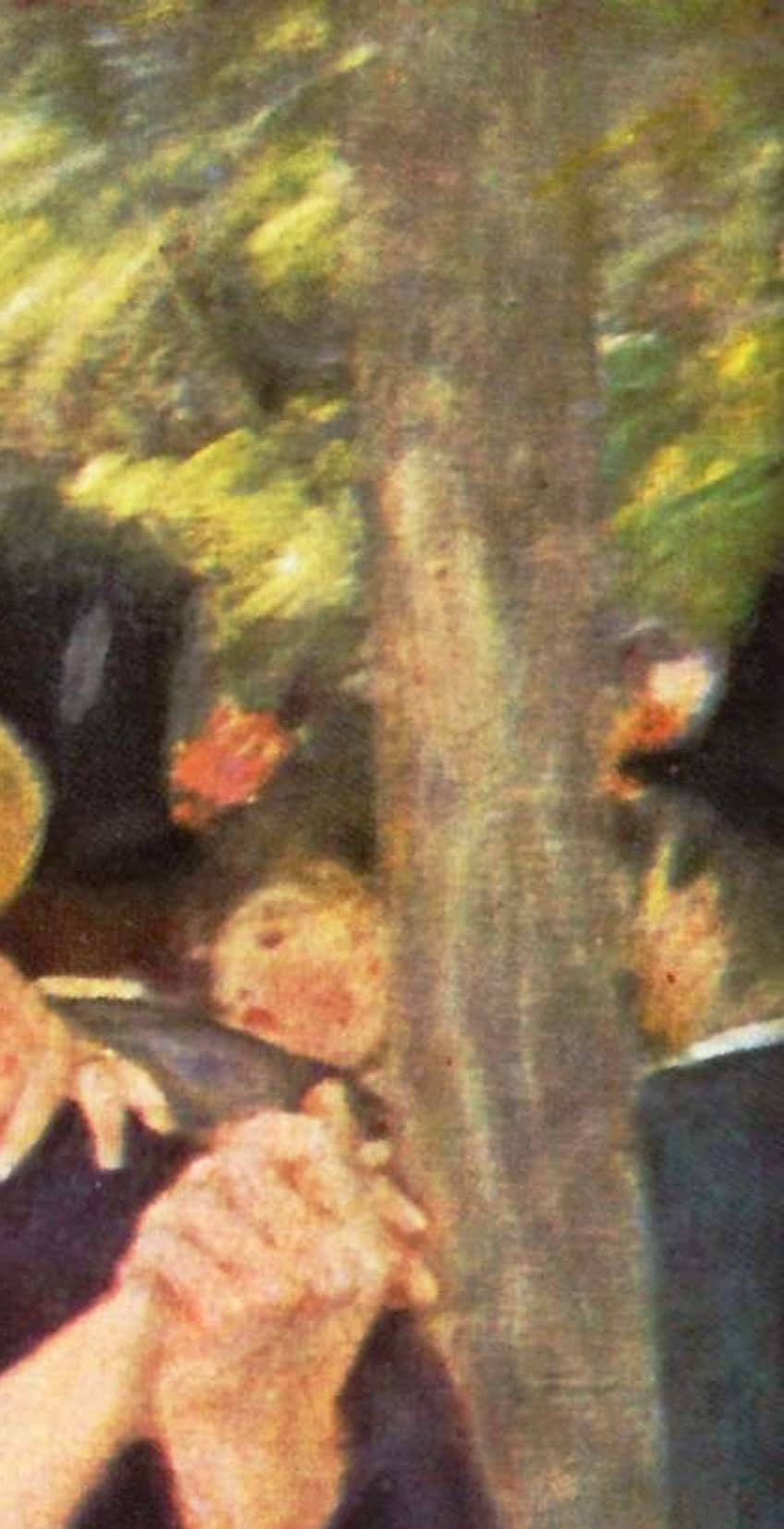
Space
Renoir placed the focus on the dancing couple who are close in the foreground and larger in size compared to the figures in the background, who appear slightly smaller and farther away. The orientation of the painting is vertical, which further highlights the full length of the dancers. Furthermore, the two figures in the foreground are clearer in their definition compared to the blurrier figures in the background.
This utilization of size and scale, as well as clarity of form, creates a sense of depth and perspective.

Would You Like to Dance?
The Dance at Bougival painting was exhibited in 1883, reportedly in London first, but it had a positive reception and reviews in The Academy publication. It was reportedly purchased from Jacques Seligmann by the Museum of Fine Arts in Boston in 1937 for $150, 000. It has also been described as a combination of Renoir’s Impressionistic style and a compositional vertical format, which is more Classical in its approach.

“Dance at Bougival” by Pierre-Auguste Renoir has been lauded as his most sensual rendition of the dancing couple compared to his other two artworks in the series, which are all held at the Musée d’Orsay in Paris. Renoir depicted a moment in time of a couple dancing in the open, and left us in awe as if we were dancing right alongside them.
Frequently Asked Questions
Who Painted the Dance at Bougival?
The French Impressionist painter, Pierre-Auguste Renoir, painted Dance at Bougival (1883). It is an oil on canvas and measures 181.9 x 98.1 centimeters. It is part of a series of three dance paintings, of which the other two are Dance in the Country (1883) and Dance in the City (1883), and were all commissioned by Paul Durand-Ruel.
Where Is the Painting Dance at Bougival Housed?
The oil on canvas, Dance at Bougival (1883) by Pierre-Auguste Renoir, is located at the Museum of Fine Arts in Boston, Massachusetts, the United States. It has been housed in the museum’s collection since 1937 and was purchased in 1937 for $150, 000 from Jacques Seligmann.
Who Are the People in Dance at Bougival by Pierre-Auguste Renoir?
It has been debated that the dancing couple in Pierre-Auguste Renoir’s Dance at Bougival (1883) were his friends, Suzanne Valadon and Paul Auguste Lhote. However, some studies suggest that Renoir may have painted Aline Charigot first. The male model has also been thought to be Hippolyte-Alphonse Fournaise.
Alicia du Plessis is a multidisciplinary writer. She completed her Bachelor of Arts degree, majoring in Art History and Classical Civilization, as well as two Honors, namely, in Art History and Education and Development, at the University of KwaZulu-Natal, South Africa. For her main Honors project in Art History, she explored perceptions of the San Bushmen’s identity and the concept of the “Other”. She has also looked at the use of photography in art and how it has been used to portray people’s lives.
Alicia’s other areas of interest in Art History include the process of writing about Art History and how to analyze paintings. Some of her favorite art movements include Impressionism and German Expressionism. She is yet to complete her Masters in Art History (she would like to do this abroad in Europe) having given it some time to first develop more professional experience with the interest to one day lecture it too.
Alicia has been working for artincontext.com since 2021 as an author and art history expert. She has specialized in painting analysis and is covering most of our painting analysis.
Learn more about Alicia du Plessis and the Art in Context Team.
Cite this Article
Alicia, du Plessis, ““Dance at Bougival” by Pierre-Auguste Renoir – A Jovial Artwork.” Art in Context. July 7, 2023. URL: https://artincontext.org/dance-at-bougival-by-pierre-auguste-renoir/
du Plessis, A. (2023, 7 July). “Dance at Bougival” by Pierre-Auguste Renoir – A Jovial Artwork. Art in Context. https://artincontext.org/dance-at-bougival-by-pierre-auguste-renoir/
du Plessis, Alicia. ““Dance at Bougival” by Pierre-Auguste Renoir – A Jovial Artwork.” Art in Context, July 7, 2023. https://artincontext.org/dance-at-bougival-by-pierre-auguste-renoir/.





